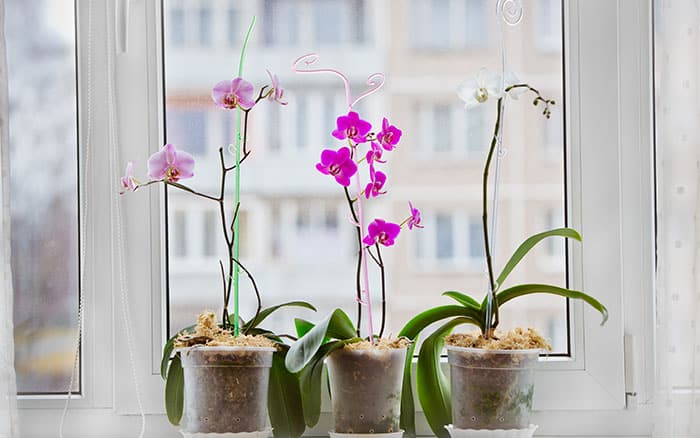This Mother’s Day treat your mum to a living plant rather than cut flowers, so she can enjoy them for much longer.
These are some of my favourite houseplants to bring her home a delightful display and put a smile on her face.
Flowers to wow
For centuries, we’ve chosen flowers to show displays of thankfulness, remembrance and love and, according to research, we do this because our brains are wired to see flowers and release a chemical in the brain called Dopamine. This stems back to when colourful plants would have promised nutritional crops, and even nowadays we find multi-coloured displays rewarding to see.
Here are some cracking houseplants to boost the beauty of your Mother’s home as well as bring her heaps of happiness:
1. Orchid Phalaenopsis (moth orchid)
This popular indoor orchid has long-lasting flowers that are produced all year round. Available in a variety of colours, including white, orange, purple, and many more.
Gifting an orchid to a loved one signifies love, luxury, beauty and strength.
Moth orchids benefit from a brightly lit room but should be shaded from direct sunlight and watered little and often.

As they photosynthesise using their roots, as well they’re best kept in a clear pot rather than an opaque one—even if it is bright and decorative. A bathroom or kitchen, where the humidity is high, would be ideal.
2. Indoor Chrysanthemum (pot mum)

These blooms come in a variety of colours, the most popular having single flowers with vibrant daisy-like yellow centres. These cheery flowers represent optimism and joy. Though, it’s said that the Victorians used Chrysanthemums to show friendship and well-wishing.
Keep these looking great by ensuring they are never left sat in water; watering them little and often when the top inch of soil becomes dry.
Again, a bright but indirectly lit windowsill works well and so does avoiding any high or low temperatures.
3. Indoor azalea
Potted azaleas make fabulous Mother’s Day presents because they flower around the same time of year. These colourful evergreens have flamboyant, frilly flowers that grow up to 30cm tall. Giving the flower to someone is said to symbolize femininity and of softness.
They differ from the azaleas we plant outside, as they’re grown specifically as houseplants. Flowering plants should be kept in a cool, humid atmosphere with plenty of light, like an unheated porch.

Azaleas are immensely thirsty plants and will need plenty of water to see them through the flowering season and beyond. Feed with Sequestered Iron for best results.
4. Indoor roses

Miniature roses are a tiny version of the popular rose bush. They have beautiful flowers and attractive dark foliage.
Each colour is said to symbolize something different. Red is said to be the lover’s rose, signifying enduring passion; white denotes humility and innocence; yellow expresses friendship and joy; pink conveys gratitude, appreciation and admiration.
This classic won’t flower if they don’t get enough sunshine, so need to be positioned on a sunny window or moved outside if there is no danger of frost.
5. Kalanchoe
This plant is so easy to keep. Known as flaming Katy, these popular succulent perennials can have red, pink, yellow or white flowers. They bloom in response to the length of daylight, so can be encouraged to bloom even through winter.
Gifting them is said to represent endurance and lasting affection. It can also symbolize wealth and prosperity. They prefer bright, sunny locations, especially during the summer.

These look especially excellent a pot plants, but their tender nature means that they don’t like draughts.
6. Anthurium (flamingo flower)

These plants are known for their strikingly bright red spathes and their ornamental leaves. Flowers are traditionally red, but you can also get them in pink and white.
They are often used in bridal bouquets but, as a potted plant, the anthurium plant symbolises abundance and happiness to the home.
Position plants in bright light—they can tolerate all levels of indirect light, but those in low light will have fewer flowers and will grow slower. It’s best to mist the leaves regularly with water to increase humidity.
7. Gardenia
The dark, attractive foliage and the showy scented flowers make this a popular choice. Delicate flowers with a sweet fragrance, Gardenias are often associated with purity, love and refinement.
Sites in non-direct, full sun that’s accessed through glass will be the best spot and make sure not to overwater.

8. Stephanotis floribunda

Madagascar jasmine has glossy leaves and a highly delightful fragrant blossom which appears from May to October, making it a popular choice for a houseplant. Gifting Stephanotis represents good fortune and happiness in marriage.
These spectacular plants thrive best in a heated conservatory but grow well in any warm and light room of the house, flowering again and again.
Tip:
Help birds with nest building by tying
bunches of small twigs, dried moss, and stringy
vegetable matter near your feeders.
With gifts like these, this year’s Mother’s Day is sure to be as spectacular as the blooms you choose to give!
Happy gardening everyone!
Reader questions
What’s the best way to water houseplants?

Plug up your kitchen or bathroom sink and fill it with about two inches of water. Stand your potted houseplants in the water for about 30 minutes and then drain them so that the excess water runs out, popping them back on the shelf sufficiently watered until the soil next feels dry to the touch.
Do trees and shrubs need feeding the same as flowers?

Though we prioritise the importance of feeding flowering or fruiting plants, all plants need access to nutrients in order to grow well—trees and shrubs are no exception. Find a well-balanced feed, like Miracle-Gro® Premium Rose, Tree & Shrub Compost, and sprinkle it over the soil surface above the roots before hoeing the topsoil and don’t forget your hedging too.

Leave A Comment